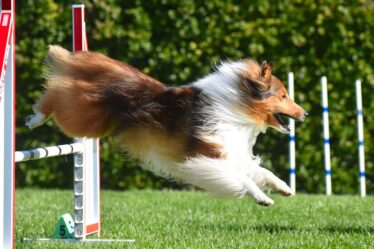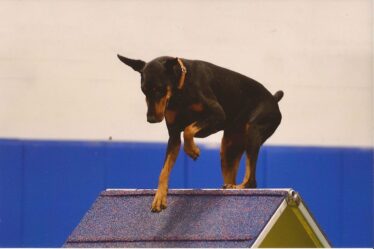
S’more lost her nail last Monday.
Once we had a game plan for helping S’more’s nail grow back, I shifted my focus to the other ouches. Ripping off a nail probably requires a good deal of force, meaning she yanked her whole front, left leg pretty hard. And, sure enough, her shoulder, bicep and chest were giving off heat. I do know this means more blood flow being directed to those muscles to help repair damaged tissue. I don’t know the specific muscles, tendons or ligaments that would have been impacted by such a yank. I also don’t know what direction she yanked. Pulling the leg back or yanking away while the leg is in front; these different positions change how the muscles and connective tissues were impacted.
Long story short, I don’t know how she did it or when she did it. I know two things: 1) that probably hurt and still hurts & 2) we’re now in recovery mode.
Now, it’s important to note that at no point did S’more limp and she was not in excessive pain. If so, we would have taken additional steps to see if there was any damage to the bones or tendons above the nail.
When we encounter a minor injury, like a ripped pad, broken nail or are really sore – like after a big weekend of hiking, our dog’s need extra recovery time. But, recovery doesn’t just take time. I do my best to use that time intentionally to help my dogs (or, myself) heal properly and regain normal functioning. The following activities are what I have been including to help S’more recover and get back to agility. Every injury is unique; the structure of the dog, the accident, the chronic wear n’ tear, and so, so many other factors come into play. These are the general guidelines I follow for my own dog’s recovery and, to some extent, my own recovery as an athlete. I am always learning more, reflecting on past mistakes and trying to do my best. If you need help with your own dog or want to learn more, I encourage you to work with a physical therapist or veterinarian that specializes in dog sports and sports rehabilitation.
Recovery Guidelines
1. I don’t ice.
Ice restricts blood flow from reaching damaged tissue. Blood flow brings in necessary materials for repairing damaged tissue and takes away by products of the recovery process. Icing can kill red blood cells as they arrive and those damaged cells pool in the injured area. This can increase the time to recovery. I would only ice under special circumstances when prescribed by an expert that specializes in dog sports rehabilitation.
2. I use active recovery methods.
Active recovery means using movement to encourage blood flow to and through damaged tissues. Typically for my dogs this includes active stretching (i.e. dog moves themselves into different stretch positions) and walking. For people, light strength training, biking and swimming can also be great choices. These are a bit harder for a dog and we need to manage the dog’s intensity. Active recovery activities should be low intensity; no fetch, no spinning quickly, no jumping, no landing, no sprinting, and no pulling.
I keep all our activities low intensity until our initial injury is healed.
For example: A lose leash walk is a very different physical stimulus than pulling the owner down the street or breaking into a run. Pulling in particular should be avoided – always. Not only is your dog likely pulling significantly more than their body weight, they’re likely pulling from a non-advantageous position depending on your collar or harness choice. Overtime, this can add strain to already sore and damaged muscles and cause muscular imbalances. I always bring treats on walks to encourage my dogs to keep a loose leash, and reward my dogs for continuing forward rather than tugging them forward. With lots of squirrels in the neighborhood and a bored border collie, this is a challenge. But, it is worth every cookie to keep S’more walking calmly and at an appropriate pace.
I incorporate active stretching multiple times a day during recovery. Using treats I ask my dog to move into different positions to extend and stretch certain muscles. Overtime, active stretching can increase mobility – the ability of my dog’s joints to move through a full range of motion. This involves moving slowly into different positions relying on the body’s ability to move safely into a position. This means the dog is actively using muscles to stay balanced and maintain coordination while expressing flexibility. This can help increase range of motion and prepare the body to use those muscles and joints in activity.
Yes – I do active stretching before agility for myself and my dog.
3. I use passive recovery methods.
Passive recovery means an outside force (aka: you or another human) are manipulating the dog’s body. This can be massage or stretching which also brings blood flow to and through the damaged tissue.
When I massage my dogs I use a very light pressure on their muscles and watch for signs of distress (i.e. fussing, licking or staring at me). I try my best to massage in the direction of the muscle fibers – you wouldn’t massage your calf muscle left to right, you massage up and down. Also, I never “dig in” with my fingers.
When I passive stretch my dogs I use a very light pressure to move their limbs and watch for signs of distress (i.e. fussing, pulling the leg away or staring at me). My objective is to work my dogs’ legs through their current range of motion. This means moving into extension, flexion, abduction and adduction for different muscles. I focus on the shoulder joint and hips; which involves dozens of muscles moving into all these positions.
This may not always be what you consider as “full” range of motion – if injured or tight, your dog’s tissues may not stretch to their normal abilities. Just like my ability to touch the floor often depends on the tightness of my hamstring muscles. Someone else forcing my body into over extension or flexion risks tearing or straining the tissues around my hip joint – not good for humans or dogs. Moving the leg into a position that my dog is comfortable with is the goal during passive stretching. This can sometimes be a farther range of motion than they can reach on their own with self stretching. Overtime, I can increase and/or maintain flexibility of my dog’s muscles and connective tissue.
I do not use passive stretching before activity or agility – but I do use passive stretching directly after exercise and always after an agility day. After massage or passive stretching, I always offer my dogs lots of water or give them a hydrating snack (like watermelon). Extra fluids will help their body process any of the damaged cells that are moving away from injured areas.
4. I look for indications of improved well-being.
This might include self stretching through improved range of motion, relaxing during massage or passive stretching, or more mobility in active stretches. While I wait for the nail to grow back, I also want to see some of the additional soreness or tightness to dissipate. This took approximately 7-8 days for S’more. If I don’t think it was “that bad” or that she wasn’t in “that much pain”, why would it take over a week for her to feel better?
5. I recognize that compensation and in-activity lengthen recovery time.
Compensation means your dog is putting more load on other muscles to complete activities, like shifting your weight from one leg to the other when standing. This is fairly clear when your dog is limping; the uninjured legs are doing WAY more work and these dysfunctional movement patterns are costly. So, when I put a sock on S’mores foot I am forcing her to compensate because socks are evil and she doesn’t walk normally. While this is necessary to keep her toe clean, it also means I need to limit her activity as much as possible. The same goes for a cone or other instruments you’re attaching to the dog to aid in the healing process. If it changes how your dog holds their head or moves their legs you’re likely going to see additional soreness in places other than the initial injury site due to compensation.
To minimize in-activity I focus on activities throughout the day that drive blood flow to the injured area – like the passive and active recovery methods mentioned above.
6. I spend equal amount of time recovering as I do coming back to sport.
For S’more, I anticipate we’ll have a full nail by the end of the week. That’s about 15 days in recovery, and we’ll spend 15 days coming back to agility. This means that she will not be on full height equipment or running courses until then. For now, we’ll keep “agility sessions” short focusing mostly on foundational movements; working technique at a slow speed and no jumping. I’ll be spending time passively stretching and massaging her foot to help any muscles or connective tissue that were impacted by the nail being ripped or yanked off. And we’ll be focusing on mobility (using active stretches) and strength training (using our core work exercise – you can find experts for that too!) to get back to agility safely.
I know that S’more has not lost her ability to do agility. She is plenty fit, and two weeks of rest doesn’t deteriorate that much muscle. But, gradually coming back to sport decreases the likelihood of reinjuring the toe or another part of her body.
For major injuries, surgery or a longer break from agility, more time is needed to bring the dog back to sport safely.
Now, here’s the real secret. These recovery techniques aren’t just for recovering from minor or major injuries. Using recovery techniques every day can help your dog improve their fitness, reduce risk of future injury and may increase their longevity in the sport.



